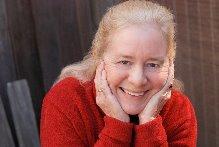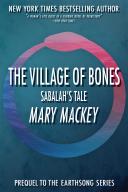Today we are going to talk with Mary Mackey whose new historical novel, The Village of Bones: Sabalah's Tale was released this month. Mary is a bestselling author who has written seven volumes of poetry including Sugar Zone, winner of the 2012 PEN Oakland Josephine Miles Award for Literary Excellence. She is also the author of fourteen novels some of which have appeared on The New York Times and San Francisco Chronicle BestsellerLists. Mackey's novels have been translated into twelve languages.
Sabalah's Tale was released this month. Mary is a bestselling author who has written seven volumes of poetry including Sugar Zone, winner of the 2012 PEN Oakland Josephine Miles Award for Literary Excellence. She is also the author of fourteen novels some of which have appeared on The New York Times and San Francisco Chronicle BestsellerLists. Mackey's novels have been translated into twelve languages.
Andy: Let's cut to the chase, Mary: what happens in this novel? What's The Village of Bones about?
Mary: Six thousand years ago, bands of marauding nomads from the northern steppes invaded what is now Bulgaria and Romania, bringing horses, male gods, and genocidal warfare to a peaceful, Goddess-worshiping Europe that had existed almost unchanged for thousands of years. This was a real invasion, with real consequences that we are still living with today.
In The Village of Bones I tell the story of a young priestess named Sabalah who conceives a magical child with a mysterious stranger named Arash. Sabalah names her child "Marrah." Marrah will save the Goddess-worshipping people from the nomad invaders, but only if her mother can keep her alive long enough to grow up. Warned in a vison of the coming nomad invasion, Sabalah flees west with Arash to save her baby daughter, only to discover that she is running into the arms of her worst enemies. In the vast forests of northern France, other human-like species left over from the Ice Age still exist, and they are not-to say the least-friendly.
Andy: There are other best-selling books that take place in pre-historic times. Is there anything in The Village of Bones that will remind readers of books or films they've enjoyed?
Mary: You'll definitely be reminded of The Clan of the Cave Bear, The Mists of Avalon, and Avatar. Also, there are some scary giant sharks that eat anything in their path, including one another. When I say "giant" I mean really GIANT. I based them on the Megalodon sharks, which. lived 2.6 million years ago, were 45 feet to 59 feet long, weighed 50 tons, and had teeth seven inches long. If you heard the theme music from Jaws playing in your head as you read that, it's no coincidence. Then there's the Mother Book, an ancient, sacred text that contains all knowledge, past, present and future, including the knowledge of how to travel through time. As you read about Sabalah's race to save the Mother Book from falling into the hands of the Beastmen, you may find yourself reminded of The Da Vinci Code.
Andy: You've said this novel explores the "original inspiration for the stories of fairies, gnomes, elves, and other magical creatures which appear so often in European folk tales." Can you explain what you mean by this?
Mary: In the Village of Bones, I choose to imagine that other human-like creatures survived in small numbers in the forests of northern Europe. At present, we know about a number of ancient species that were human-like but not strictly human. The best known are the Neanderthals, who play a central role in The Clan of the Cave Bear. The Neanderthals actually interbred with humans, so we're all a part Neanderthal. The lesser known Denisovans also seem to have interbred with human beings. Other human-like ancient beings we know about include Homo floresiensis, Homo erectus, and Homo habilis.
As I began to write The Village of Bones, I came to wonder if perhaps small bands of these human-like beings survived long enough to be the original inspiration for the stories of fairies, gnomes, elves, and other magical creatures which appear so often in European folk tales.
Imagine for a moment that you are living 6,000 years ago, walking through the forest, minding your own business, when you stumble across a little man who is only three feet tall, covered with hair, and not quite human-looking. You might well think he is a magical creature, an elf, a fairy, a Hobbit.
Andy: Would you call this novel historical fiction, science fiction, or fantasy?

Andy: How did you become interested in the Goddess-worshiping cultures of Prehistoric Europe?
Mary: I didn't know anything about them until I got a phone call one day from the head of HarperSanFrancisco. He had read my novel The Last Warrior Queen, which is about the Goddess-worshiping cultures of Prehistoric Sumeria. He told me he was about to publish a non-fiction book that dealt with the Goddess-worshiping cultures of Prehistoric Europe and asked me if would I be interested in writing a novel on the same topic. The manuscript of the non-fiction book he was about to publish turned out to be The Civilization of the Goddess by Professor Marija Gimbutas. Ten pages into it, and I was hooked. I began to write The Year the Horses Came about a week later.
Andy: Will Twenty-First Century readers find the story of these cultures relevant to their own lives?
Mary: Yes and no. Yes, because many of the issues my characters face are issues we face today. For example, the Goddess-worshiping cultures of 6,000 years ago considered the Earth both sacred and alive. We're slowly killing the planet, and perhaps ourselves, by treating the Earth as a piece of real estate to be exploited instead of as a sacred trust to be tended.
No, because everything doesn't have to be relevant all the time. Sometimes all we want is to put the troubles and anxieties of our everyday lives aside and go on vacation to some place new and exotic: back to the past, back to a world of magic and adventure where the mortgage never comes due, the computer never crashes, and interesting things happen.
Andy: How do you do research for a novel set 6,000 years ago? How close do you stick to the facts?
Mary: One reason I write historical novels is that the research is so much fun. To write The Village of Bones and the other three novels in The Earthsong Series, I traveled extensively through Europe scouting out locations so I could describe them accurately and visiting museums so I could see what was left from the cultures I was portraying. I saw the Great Nomad Gold Horde in Varna Bulgaria; statues of Snake Goddesses in Bucharest Romania; ancient cave paintings in southern France; Standing Stones in Brittany.
Contrary to what you might imagine the realistic parts of the novel were actually the easiest to write because I had the extensive research of Professor Marija Gimbutas to draw on. Professor Gimbutas, who taught for many years at UCLA, devoted her life to studying the Goddess-worshiping cultures of prehistoric Europe. Her two books The Language of the Goddess and The Civilization of the Goddess are gold mines of informationProfessor Gimbutas generously helped me with the research when I was writing the first two novels in the Earthsong Series. Without her personal help and her work to draw on, it would have taken me a decade to write The Village of Bones instead of two years. She did all the hard work. All I had to do was pick up the bones she had uncovered, put flesh on them, and make them dance.
Andy: This is your fourteenth novel. Do you plan to write any more novels in this series?
Mary: Yes. The Village of Bones comes to an exciting climax and a satisfying conclusion, but I have left some loose strings which I intend to pick up at some future date.
Andy: Tell us a little bit about why you write historical fiction. Do you read historical fiction? What are some of your favorite books in the genre?
Mary: I've always loved historical fiction as long as it's meticulously researched, accurate, not preachy, filled with interesting characters, and tells a great story. Some of my favorites are: The Color Purple by Alice Walker; The White Queen by Philippa Gregory; The Eagle in the Snow by Wallace Breem; The Persian Boy by Mary Renault; A Tale of Two Cities by Charles Dickens; The Bluest Eye by Toni Morrison, Roman Blood by Steven Saylor, and The Name of the Rose by Umberto Eco. The list goes on and on. I'm always looking for new ones.
Tags: andy ross, book publishing, books, literary agent, mary mackey, Village of Bone
